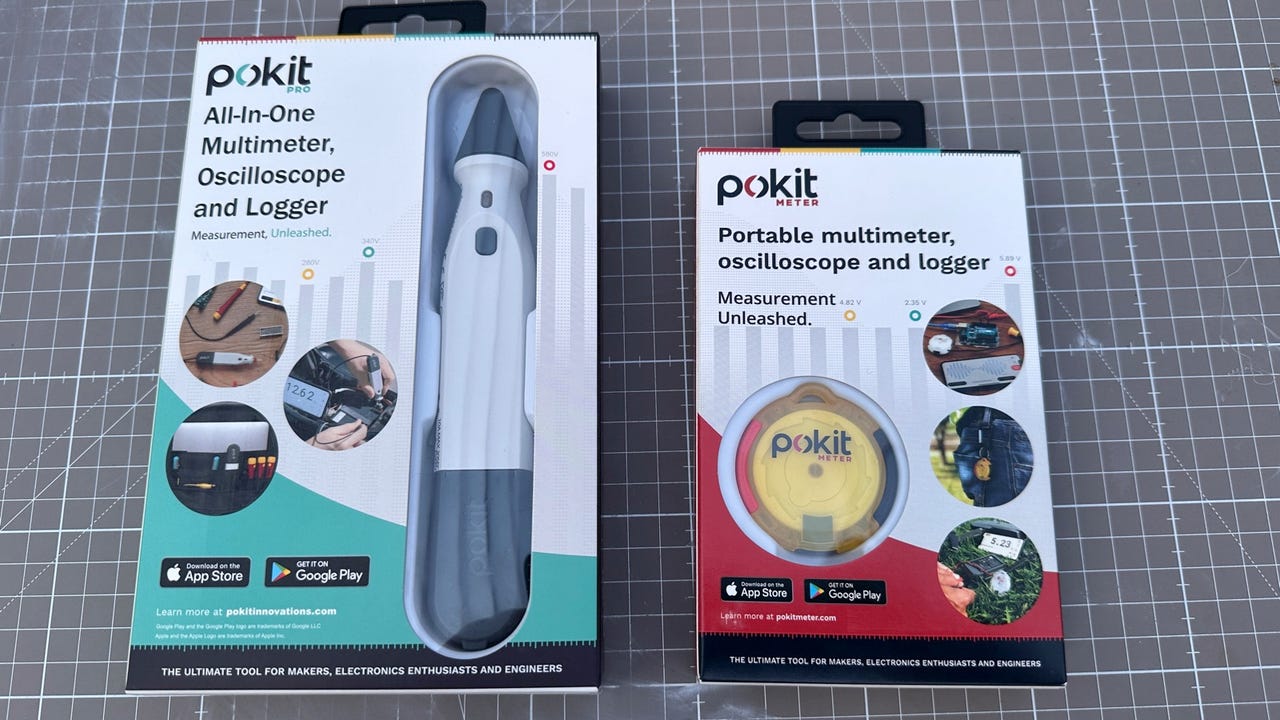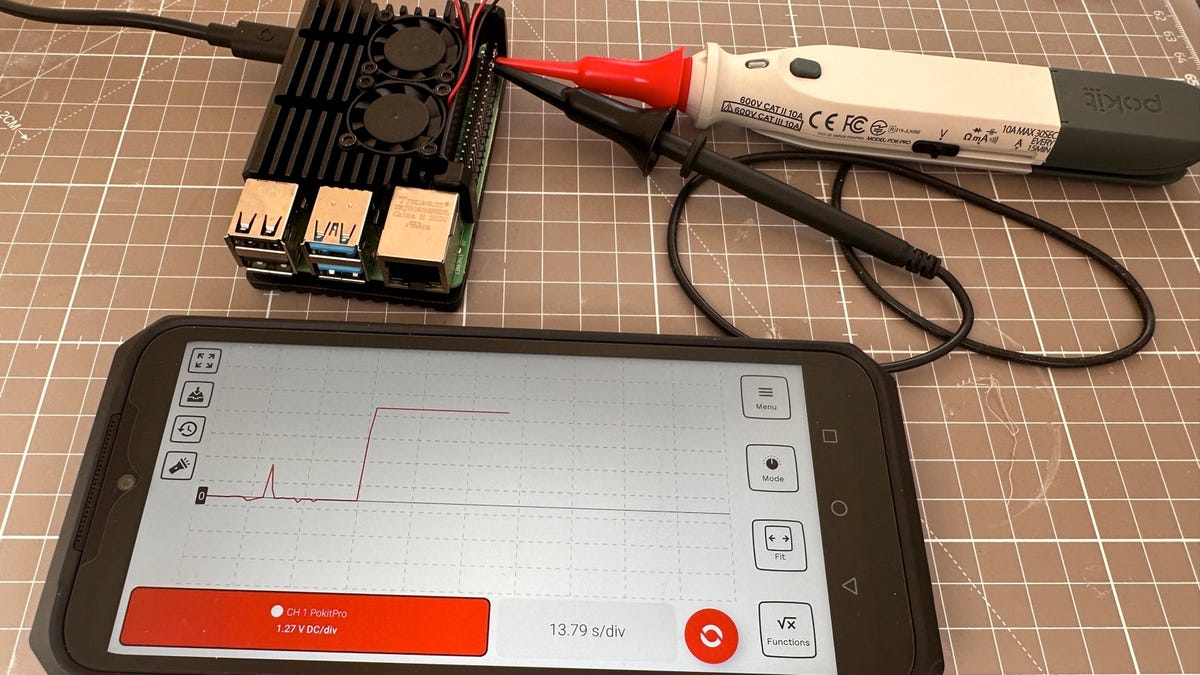Why I replaced my $40 multimeter with “smart” measuring tools

A tool that I use a lot for day-to-day diagnostics and troubleshooting is the humble multimeter. My go-to unit for the past few years has been the super reliable, super useful Kaiweets HT206D. Priced at under $40, this thing has paid for itself many times over.
Not only has it had a hard life and has suffered a bit of damage, but it’s also missing a few features that I think would be beneficial from a multimeter.
Also: This tiny keychain is a mighty tool for your personal safety
For example, the Kaiweets can’t log data, so the information you get is limited to what is displayed on the screen. It’s also wired, so you need to be in front of the display the whole time, and there’s no option to have the information beamed to your smartphone over Bluetooth. And finally, there’s no oscilloscope feature that allows you to capture data such as voltages many times a second and display that as a waveform, which is an extremely useful troubleshooting feature.
So, I went in search of a smart multimeter, and I ended up getting two for testing: the Pokit Pro, and its smaller sibling, the PokitMeter.
Both of these devices are “smart” in that they combine the features of a multimeter, an oscilloscope, and a data logger into a single device, and also connect to an app on your smartphone, doing away with the need for a screen on the meters.
Pokit Pro
The lead to the second probe is an ideal length. Adrian Kingsley-Hughes/ZDNET
The Pokit Pro is a neat, compact probe-style multimeter. The lead to the second probe is a generous 700 mm/27.5 inches, which is long enough to be useful and short enough to not get in the way. It wraps neatly around the multimeter when not in use.
Also: This is the perfect mini electric screwdriver
Tech specs
- Measures: AC/DC voltage, AC/DC current, resistance, continuity, diode polarity, and ambient temperature
- Rating: Max 600VAC/VDC, CAT III
- Measurement ranges:
Voltage: 1mV to 600V AC/DC (True RMS), ±1%
Current: 1uA to 10A AC (True RMS)/DC max, ±1%
Resistance: 100m to 1M Ohm, ±1%, 3M Ohm ±3%
Continuity and Diode polarity check: Yes
Sampling: 1M sample/sec at 12bit
Logging Period: up to 6 months - Kit: 1x Pokit Pro, 1x hard case, 2x probe clips, 2x CAT III probe tip sheaths, charging cable (USB-A to USB-C)
- Apps: iOS and Android
You can switch between settings with the switch on the side of the probe. Adrian Kingsley-Hughes/ZDNET
Connecting the Pokit Pro to the app was a breeze, but expect a lot of safety warnings. I highly recommend that you read the manual carefully. While this is a CAT III-rated multimeter, which means it’s rated to be safe up to 600VAC/VDC, you should still be careful when dealing with high voltages.
The safety warnings on the app. Adrian Kingsley-Hughes/ZDNET
Once connected to a smartphone, you can start using the Pokit Pro. Here’s what it looks like graphing voltages.
The phone is your main display for statistics and recordings. Adrian Kingsley-Hughes/ZDNET
And here’s the Pokit Pro acting as a standard multimeter. There’s definitely a learning curve to using the software, and I’ve found myself getting lost in all the settings, but this is something that practice will no doubt make better.
There’s plenty of functionality here. Adrian Kingsley-Hughes/ZDNET
On the end of the probe is an LED light that can be switched on in the app. It’s especially handy when you want a clearer view of what you’re poking at.
I’ve tested the Pokit Pro with up to 250 volts of AC power in the U.K. and it worked fine.
Measuring 250 volts AC with the Pokit Pro. Adrian Kingsley-Hughes/ZDNET
PokitMeter
Everything that’s included with the PokitMeter. Adrian Kingsley-Hughes/ZDNET
Now, let’s take a look at the smaller, more compact “keychain” PokitMeter. It comes in a tiny kit containing the meter, little probes, and a carry case.
Also: This tiny smartphone accessory gives you a fantastic superpower
Tech specs
- Measures: AC/DC voltage, AC/DC current, resistance, continuity, diode polarity, and ambient temperature
- Rating: Max 60VDC, 48VAC
- Measurement ranges:
Voltage: 10mV to 60V DC, 42V AC (RMS), ±1%
Current: 1mA to 2A max, ±1%
Resistance: 1 to 1M Ohm, ±5%
Continuity and Diode polarity check: Yes
Sampling: 1M sample/sec at 12bit
Logging period: up to 6 months - Kit: 1x PokitMeter, 1x zip pouch, 2x detachable wire clips, 1x battery, 2x 2A fuses
- App: iOS and Android
The leads on the PokitMeter ratchet out of the body when you pull either side, extending out to a total length of 400mm or 16 inches.
The leads ratchet out of the body of the PokitMeter.
Adrian Kingsley-Hughes/ZDNET
And when you’re done, they wind themselves back into the meter with a press of a button — like a measuring tape!
To prevent any damage, hold onto the lead as it’s retracting.
Adrian Kingsley-Hughes/ZDNET
Here’s what the detachable wire clips look like. They fit onto the ends of the probes easily.
Connecting the PokitMeter to the app is simple and straightforward. Again, owners are warned of the limitations of the meter and encouraged to read the manual.
The PokitMeter is tiny but great for low-voltage diagnostics such as automotive troubleshooting.
Here’s the PokitMeter in action! Adrian Kingsley-Hughes/ZDNET
Are they worth it?
At $250 for the Pokit Pro and $129 for the PokitMeter, these tools are not cheap. If you’re starting out, then I highly recommend getting a cheap and cheerful (yet safe) multimeter such as the Kaiweets multimeter that I previously used.
But, remember, the Pokit Pro is not just a regular multimeter. If you are more experienced and know how to get the most out of your tools, then this could be a perfect fit for you. It’s just as valuable for users who want an oscilloscope and data logger.
I’m going to use these multimeters exclusively for the next few weeks to test them to the limits and see whether I think they’re worth the money, but the initial testing I’ve done suggests that they’re very capable meters that deliver on what they promise.
That’s a lot of power…if you know how to make use of it!




